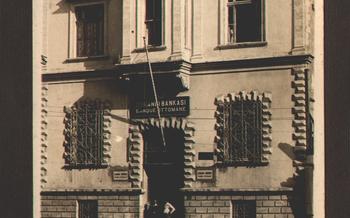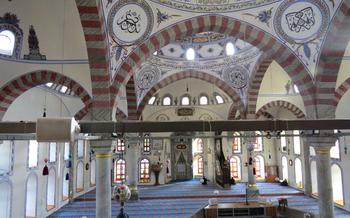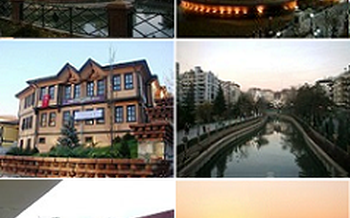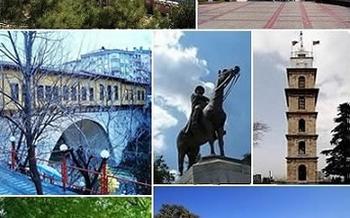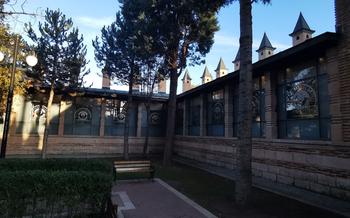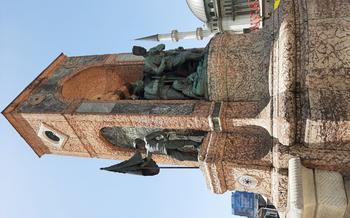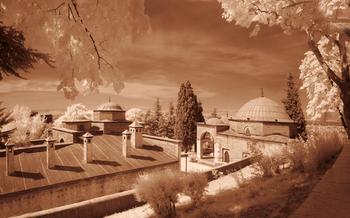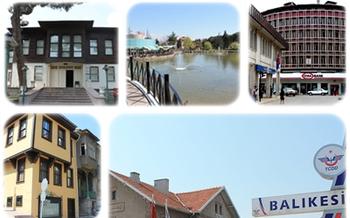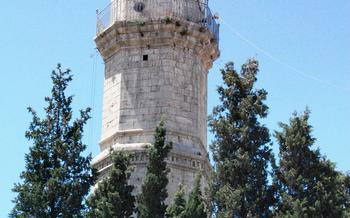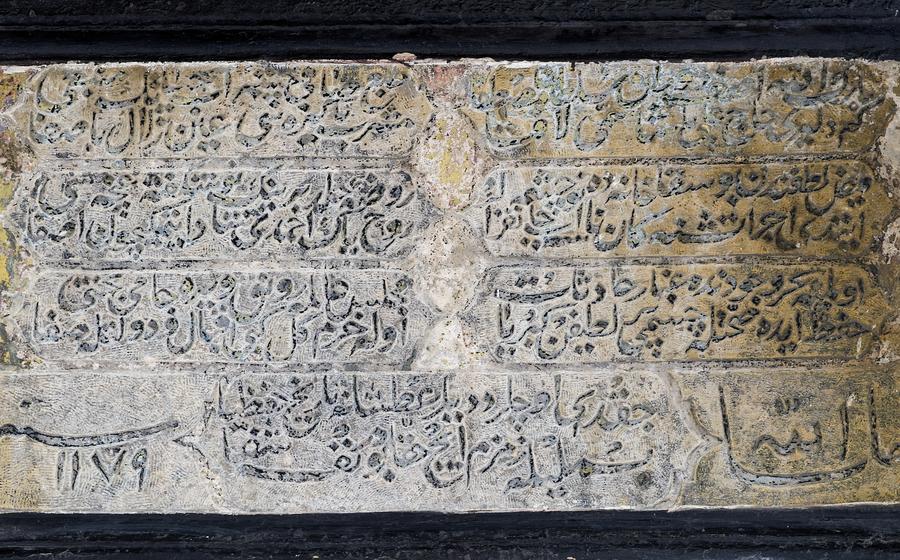
Kütahya Ulu Mosque
- Kütahya Ulu Mosque: An Architectural Masterpiece
- The Grand Courtyard: A Place of Tranquility
- The Prayer Hall: A Sanctuary for Worship
- The Ablution Fountains: A Place for Purification
- The Minaret: A Tower of Faith
- The Tomb of Sheikh Edebali: A Place of Reverence
- The Museum of Kütahya Tiles: A Treasury of Art
- The Köfteciler Çarşısı: A Foodie's Paradise
- The Germiyan Museum: A Journey Through History
- The Tavşanlı Canyon: A Natural Wonder
- The Porsuk River: A Scenic Spot
- The Kütahya Ceramic Festival: A Celebration of Art
- Insider Tip: Planning Your Visit
- Best Time to Visit
- Dress Code and Etiquette
- Travel Tips and Recommendations
Kütahya Ulu Mosque: An Architectural Masterpiece
Historical Significance:
The Kütahya Ulu Mosque stands as a testament to the rich history and cultural heritage of Kütahya. Constructed during the Seljuk era in the 13th century, the mosque played a pivotal role as the principal place of worship for the city's Muslim community. Over the centuries, it underwent several renovations and additions, reflecting the evolving architectural styles and influences that shaped Kütahya's urban landscape.
Architectural Features:
The Kütahya Ulu Mosque captivates visitors with its exquisite architectural features. Its exterior facade is adorned with intricate stone carvings and decorative elements, showcasing the Seljuk's mastery of craftsmanship. The mosque's interior is equally impressive, featuring a spacious prayer hall supported by elegant columns and arches. The walls are adorned with vibrant tiles and calligraphy, creating a visually stunning and inspiring ambiance.
Location and Accessibility:
Conveniently situated in the heart of Kütahya, the Kütahya Ulu Mosque is easily accessible to visitors. It is located within walking distance from the city center and is well-connected by public transportation. Whether you are a history buff, an architecture enthusiast, or simply seeking a spiritual retreat, the Kütahya Ulu Mosque is an unmissable destination that offers a glimpse into the rich cultural tapestry of Turkey.
The Grand Courtyard: A Place of Tranquility
As you step into the grand courtyard of the Kütahya Ulu Mosque, a sense of tranquility envelops you. The sprawling space, adorned with intricate Islamic art and symbolism, invites contemplation and reflection. The courtyard's central feature is a large ablution fountain, where worshippers perform ritual cleansing before prayers. Surrounding the courtyard are arched colonnades, each featuring unique designs and patterns, adding to the overall aesthetic charm.
The courtyard's layout and architecture are carefully designed to create a serene and spiritual atmosphere. The open space allows for natural light to illuminate the courtyard, casting beautiful shadows and highlighting the architectural details. The use of arches and columns creates a sense of symmetry and order, contributing to the overall harmony of the space.
Whether you're a religious devotee or simply an admirer of Islamic architecture, the grand courtyard of the Kütahya Ulu Mosque offers a sanctuary for contemplation and appreciation. Take a moment to sit on one of the benches, soak in the peaceful ambiance, and let the beauty of the surroundings transport you to a realm of tranquility and serenity.
The Prayer Hall: A Sanctuary for Worship
The prayer hall, also known as the haram, is the heart of the Kütahya Ulu Mosque, where devout Muslims gather to perform their daily prayers. The vast interior of the hall exudes a sense of tranquility and awe, enhanced by the intricate designs and decorations that adorn its every corner.
Upon entering the prayer hall, visitors are greeted by rows upon rows of intricately woven carpets, inviting them to kneel and prostrate in communion with the divine. The high ceiling, supported by a series of elegant columns, adds to the grandeur of the space, creating a sense of verticality that draws the gaze upwards.
The focal point of the prayer hall is the mihrab, a beautifully decorated niche in the qibla wall that indicates the direction of Mecca. The mihrab of the Kütahya Ulu Mosque is a masterpiece of Islamic art, adorned with colorful tiles and intricate carvings that depict verses from the Quran. It serves as a reminder of the mosque's religious significance and the importance of facing Mecca during prayer.
To the right of the mihrab stands the minbar, an elevated platform from which the imam delivers his sermons and leads the congregation in prayer. The minbar of the Kütahya Ulu Mosque is a splendid example of craftsmanship, featuring intricate woodwork and carvings that showcase the artistry of its creators.
The prayer hall of the Kütahya Ulu Mosque is not just a place of worship; it is a sanctuary where the faithful can find solace, peace, and a connection with the divine. The harmonious blend of architectural elements, intricate designs, and spiritual symbolism creates an atmosphere conducive to contemplation and devotion.
The Ablution Fountains: A Place for Purification
Located in the courtyard of the Kütahya Ulu Mosque, the ablution fountains are an integral part of the Islamic tradition of cleanliness and purification before prayer. These fountains, also known as şadırvan in Turkish, are elegantly designed with intricate carvings and adorned with beautiful tiles.
The ablution fountains serve a practical purpose for Muslim worshippers, allowing them to perform the ritual of wudu, which involves washing specific parts of the body with water. Each fountain has multiple taps, ensuring that there is sufficient water for everyone to perform their ablutions in a timely manner.
The ritual of wudu is an important aspect of Muslim worship, as it is believed to purify both the body and the soul. By washing their hands, face, arms, and feet, worshippers cleanse themselves physically and mentally, preparing themselves for the spiritual act of prayer.
The ablution fountains at the Kütahya Ulu Mosque thus hold both practical and symbolic significance. They not only facilitate the performance of wudu but also contribute to the overall spiritual atmosphere of the mosque, reminding worshippers of the importance of cleanliness and purity in Islamic practice.
The Minaret: A Tower of Faith
Amidst the serene courtyard, the minaret of the Kütahya Ulu Mosque stands tall, a beacon of faith and devotion. Embodying Seljuk architectural prowess, the minaret rises gracefully towards the heavens, its intricate brickwork and decorative bands showcasing the artistry of its creators.
Ascending from a square base, the minaret transitions into a cylindrical form, featuring an elegant balcony adorned with muqarnas ornamentation. The balcony's balustrades and arched openings lend a sense of lightness and airiness to the structure.
The minaret's primary function is to serve as a platform for the call to prayer, the melodious voice of the muezzin echoing across the city, summoning the faithful to prayer five times a day. The minaret's height ensures that the call reaches far and wide, inviting the community to gather within the mosque for their religious obligations.
Beyond its practical purpose, the minaret also holds symbolic significance. Its towering presence symbolizes the steadfastness of faith, reaching towards the heavens as a representation of humanity's connection to the divine.
The minaret's architectural style reflects the fusion of Seljuk and Anatolian influences, showcasing the region's rich cultural heritage. Its intricate brickwork and decorative elements are a testament to the skill and craftsmanship of the artisans who built it.
As the sun casts its golden rays upon the minaret, the intricate shadows cast upon the mosque's courtyard create a mesmerizing spectacle. The interplay of light and shadow adds another dimension to the minaret's beauty, transforming it into a captivating work of art.
The Tomb of Sheikh Edebali: A Place of Reverence
Nestled within the sacred precincts of the Kütahya Ulu Mosque, the Tomb of Sheikh Edebali stands as a testament to the life and legacy of a revered Islamic scholar and spiritual guide. Sheikh Edebali was a prominent figure in the 13th century, known for his wisdom, piety, and profound influence on the Ottoman Empire's founder, Osman I.
The tomb, built in honor of Sheikh Edebali, exudes an air of serenity and reverence. Its intricate tilework, calligraphy inscriptions, and elegant architectural details reflect the deep respect and admiration held for the sheikh. Here, visitors can pay homage to a man who played a crucial role in shaping the spiritual and cultural foundations of the Ottoman Empire.
The tomb's architectural design showcases a harmonious blend of Seljuk and Ottoman styles. Its octagonal shape, adorned with delicate carvings and intricate tilework, creates a visually captivating exterior. The interior features a cenotaph adorned with verses from the Quran, symbolizing the sheikh's devotion to his faith.
As visitors step inside the tomb, they are enveloped in an atmosphere of tranquility and spirituality. The soft light filtering through the stained-glass windows casts a warm glow on the intricately decorated walls, creating a sense of awe and reverence. The tomb serves as a reminder of Sheikh Edebali's enduring legacy and the profound impact he continues to have on the hearts and minds of those who visit his resting place.
The Museum of Kütahya Tiles: A Treasury of Art
Nestled in the heart of Kütahya, the Museum of Kütahya Tiles is a treasure trove of ceramic art, showcasing the city's rich history and vibrant artistic traditions. As you step through the doors, you'll be greeted by an array of exquisite tiles, each a testament to the skill and artistry of Kütahya's master craftsmen.
The museum's collection spans centuries, from the early Islamic period to the present day, offering a comprehensive overview of the evolution of Kütahya's ceramic industry. Among the highlights are stunning examples of Iznik tiles, renowned for their intricate designs and vibrant colors. These tiles, once used to adorn the walls of mosques and palaces, showcase the artistic flourishing of the Ottoman Empire.
In addition to Iznik tiles, the museum also houses a significant collection of Kütahya tiles, which are distinguished by their unique style and motifs. These tiles, often featuring floral patterns and geometric designs, have been used to decorate mosques, public buildings, and private homes throughout Turkey.
The Museum of Kütahya Tiles is not just a showcase of ceramic art; it's also a testament to the cultural heritage and craftsmanship of the region. As you wander through the galleries, you'll gain a deeper appreciation for the artistry and skill that goes into creating these beautiful tiles.
The Köfteciler Çarşısı: A Foodie's Paradise
Nestled in the heart of Kütahya, the Köfteciler Çarşısı is a gastronome's haven, alluring food enthusiasts with its tantalizing aromas and delectable offerings. This vibrant market, dedicated solely to the art of crafting and savoring köfte, the beloved Turkish meatballs, is a culinary paradise where taste buds come alive.
As you step into the bustling çarşı, your senses are immediately captivated by the sizzling sounds of köfte being grilled to perfection over charcoal fires. The air is thick with the mouthwatering fragrance of grilled meat, spices, and herbs, promising an unforgettable culinary experience.
Strolling through the narrow alleys of the market, you'll find an array of vendors, each showcasing their unique take on this beloved dish. From traditional köfte, made with a blend of lamb and beef, to more innovative variations featuring chicken, fish, or vegetables, the choices are endless.
Whether you prefer your köfte served on a bed of rice, wrapped in a warm pita bread, or accompanied by a refreshing salad, the Köfteciler Çarşısı has something to satisfy every palate. Don't miss the chance to sample the specialty of the region, the "Kütahya usulü köfte," a unique take on this classic dish that's sure to leave a lasting impression.
As you savor the delectable flavors of your köfte, take a moment to admire the skill and passion of the local chefs. Watch as they deftly shape and grill the meatballs, infusing them with a smoky aroma and a tantalizing crust. Their expertise is evident in every bite, a testament to the rich culinary traditions of Kütahya.
To fully immerse yourself in the local culture, be sure to engage with the friendly vendors and fellow diners. Ask questions about their favorite köfte recipes, learn about the history of this beloved dish, and soak up the warm hospitality that's synonymous with Turkish cuisine.
Whether you're a seasoned foodie or simply seeking a unique and authentic culinary experience, the Köfteciler Çarşısı promises an unforgettable journey into the heart of Turkish cuisine. So come hungry, embrace the vibrant atmosphere, and indulge in the delectable delights that await you.
The Germiyan Museum: A Journey Through History
Nestled in the heart of Kütahya, the Germiyan Museum invites visitors to delve into the rich history and cultural heritage of the region. This captivating museum houses a diverse collection of artifacts, documents, and exhibits that trace the fascinating story of the Germiyan Beylik, a powerful Anatolian beylik that ruled over Kütahya and its surroundings from the 13th to the 15th centuries.
As you step through the doors of the Germiyan Museum, you are greeted by an array of captivating displays that bring the past to life. From intricate manuscripts and coins to finely crafted ceramics and weaponry, each artifact tells a unique tale of the Germiyan's rise to power, their cultural contributions, and their eventual decline.
One of the highlights of the museum is the collection of historical coins. These coins, minted during the Germiyan era, provide valuable insights into the economic and political structure of the beylik. They feature intricate designs and inscriptions that showcase the artistic prowess of the Germiyan rulers.
Another fascinating section of the museum is dedicated to the Germiyan's architectural achievements. Here, visitors can admire scale models of iconic buildings and monuments constructed during the beylik's reign. These models offer a glimpse into the architectural ingenuity and grandeur that characterized the Germiyan era.
The Germiyan Museum not only showcases the material legacy of the beylik but also sheds light on its cultural and intellectual contributions. Visitors can explore exhibits on the Germiyan's literary and artistic traditions, including examples of poetry, calligraphy, and miniature paintings. These works of art provide a glimpse into the vibrant cultural landscape that flourished under Germiyan rule.
A visit to the Germiyan Museum is a must for anyone interested in delving into the rich history of Kütahya and the surrounding region. Through its captivating exhibits and artifacts, the museum offers a journey through time, allowing visitors to discover the legacy of a powerful Anatolian beylik that shaped the course of history.
The Tavşanlı Canyon: A Natural Wonder
A Majestic Gorge of Natural Beauty
Nestled in the picturesque province of Kütahya, the Tavşanlı Canyon beckons nature enthusiasts with its awe-inspiring landscapes and geological marvels. This breathtaking gorge, carved by the relentless forces of water and wind over millennia, unveils a remarkable spectacle of towering cliffs, plunging ravines, and intricate rock formations.
Exploring the Canyon's Depths
Embark on an unforgettable journey through the Tavşanlı Canyon, discovering its hidden treasures and natural wonders. Follow winding paths that lead you deeper into the gorge, revealing breathtaking views of sheer rock walls and lush greenery. Marvel at the intricate patterns and textures etched into the canyon's surface, each a testament to the artistry of nature.
A Haven for Outdoor Adventures
For the adventurous souls, the Tavşanlı Canyon offers a plethora of outdoor activities to ignite your spirit. Embark on invigorating hikes through the rugged terrain, challenging yourself with varying levels of difficulty. Scale the canyon's walls with rock climbing adventures, feeling the adrenaline rush as you conquer new heights.
A Sanctuary for Wildlife
As you venture into the depths of the Tavşanlı Canyon, keep an eye out for the diverse wildlife that calls this natural haven home. Spot soaring birds of prey circling overhead, their cries echoing through the canyon walls. Observe nimble lizards basking in the sun or catch a glimpse of shy mammals scurrying among the rocks.
A Place of Serenity and Reflection
Find solace and tranquility amidst the grandeur of the Tavşanlı Canyon. Let the gentle breeze caress your skin as you soak in the breathtaking views. Allow the sounds of nature to lull you into a state of serenity, leaving behind the stresses of everyday life. Embrace the canyon's tranquility and reconnect with your inner self.
The Porsuk River: A Scenic Spot
The Porsuk River, flowing through the heart of Kütahya, is a natural treasure that adds to the city's charm and tranquility. Its crystal-clear waters, meandering through lush green landscapes, create a picturesque setting that invites visitors to relax and unwind.
The riverbank is adorned with walking paths and seating areas, providing ample opportunities for leisurely strolls or peaceful moments of contemplation. Visitors can enjoy the serene atmosphere, the gentle sound of the water flowing, and the mesmerizing reflections dancing on the river's surface.
For those seeking more active pursuits, the Porsuk River offers various recreational activities. Visitors can embark on a scenic boat tour, gliding along the river and admiring the stunning views from a different perspective. Fishing enthusiasts can cast their lines and try their luck at catching some of the local fish species.
The riverbank is also dotted with charming restaurants and cafes, offering a delightful culinary experience. Visitors can savor delicious meals while enjoying the tranquil river views, making for a memorable dining experience.
The Kütahya Ceramic Festival: A Celebration of Art
The Kütahya Ceramic Festival is an annual event that celebrates the city's rich ceramic heritage and artistic traditions. Held every year during the summer months, the festival attracts visitors from all over Turkey and beyond who come to admire the exquisite craftsmanship and artistry of local and international ceramicists.
The festival showcases a wide range of ceramic works, from traditional pottery to contemporary sculptures, displayed in various exhibitions and workshops. Visitors can witness skilled artisans demonstrating their techniques and creating unique pieces right before their eyes. The festival also features live music performances, art demonstrations, workshops, and hands-on activities for children, making it a fun and educational experience for all ages.
If you're a lover of art and ceramics, the Kütahya Ceramic Festival is a must-visit event. Immerse yourself in the vibrant artistic atmosphere, discover the latest trends in ceramic art, and take home a unique souvenir to cherish as a reminder of your time in Kütahya.
Insider Tip: Planning Your Visit
Best Time to Visit
The best time to visit Kütahya is during the spring or autumn when the weather is pleasant and mild. Summer months can be scorching, while winters are chilly and snowy, making it uncomfortable for outdoor exploration.
Dress Code and Etiquette
When visiting religious sites like the Kütahya Ulu Mosque and the Tomb of Sheikh Edebali, it's important to dress modestly and respectfully. Avoid shorts, tank tops, and revealing clothing. Women should cover their heads with a scarf or headscarf.
Travel Tips and Recommendations
- To fully immerse yourself in the local culture, consider staying in a traditional Turkish guesthouse or boutique hotel.
- Sample the delicious local cuisine, particularly the köfte and the ceramic-baked dishes.
- Take advantage of the vibrant nightlife, with bars, restaurants, and cafes offering live music and entertainment.
- Engage with the friendly locals who are known for their hospitality and warmth.
With its rich history, stunning architecture, and diverse attractions, Kütahya offers an unforgettable travel experience that will leave you enchanted and amazed.
